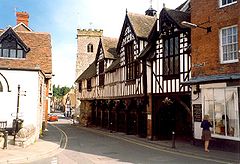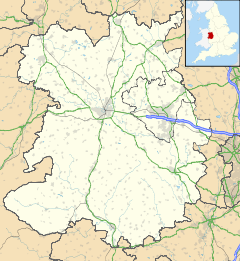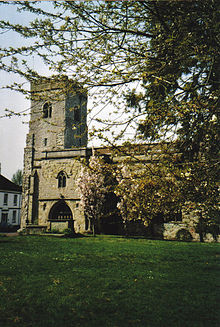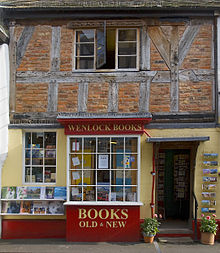- Much Wenlock
-
For the geological epoch, see Wenlock epoch.
Coordinates: 52°35′48″N 2°33′29″W / 52.5966°N 2.5580°W
Much Wenlock 
The Guildhall
 Much Wenlock shown within Shropshire
Much Wenlock shown within ShropshirePopulation 2,605 OS grid reference SO623997 Unitary authority Shropshire Ceremonial county Shropshire Region West Midlands Country England Sovereign state United Kingdom Post town MUCH WENLOCK Postcode district TF13 Dialling code 01952 Police West Mercia Fire Shropshire Ambulance West Midlands EU Parliament West Midlands UK Parliament Ludlow List of places: UK • England • Shropshire Much Wenlock, earlier known as Wenlock, is a small town in central Shropshire, England. It is situated on the A458 road between Shrewsbury and Bridgnorth. Nearby, to the northeast, is the Ironbridge Gorge, and the new town of Telford. The population of the town's parish, according to the 2001 census, was 2,605.
The "Much" was added to the name to distinguish it from the nearby Little Wenlock, and signifies that it is the larger of the two settlements. Notable historic attractions in the town are Much Wenlock Priory and the Guildhall. The name "Wenlock" as found in Much Wenlock and Little Wenlock (And also Great Wenlock, a now obsolete name, but found in some historic sources[1]) is probably derived from the Old English *Wenan loca meaning "Wena's Stronghold" (wéna being feminine and meaning "hope")[2] The town was recorded in the Domesday Book as Wenloch[2].
Contents
History
The town grew around an abbey or monastery founded around 680 [3] by Merewalh, a son of King Penda of Mercia. King Penda installed his daughter Milburga as abbess in 687. Milburga of Wenlock was credited with many miraculous works.[4] The abbey flourished until around 874 when a Danish Viking attack occurred. In the 11th century another religious house was built on the same site by Leofric, Earl of Mercia and Countess Godiva his wife. In the 12th century this was replaced by a Cluniac priory, established by Roger de Montgomerie after the Norman Conquest, the ruins of which can still be seen and which is now in the hands of English Heritage. It prospered until the Dissolution of the Monasteries in 1539.
Other architectural attractions include the 16th century Guildhall, many other historic buildings in the Early English style and an annual well dressing at St Milburga's Well on Barrow Street. The town was incorporated under the name of "Bailiff, Burgesses and Commonalty" by Edward IV in 1468 at the request of Sir John Wenlock, and "in consideration of the laudable services which the men of the town performed in assisting the king to gain possession of the crown," and the charter was confirmed in 1547[citation needed] by Henry VIII and in 1631[citation needed] by Charles I.[1]
The town is known for Wenlock Olympian Games set up by Dr. William Penny Brookes in 1850. In 1861 he was also instrumental in setting up the Shropshire Games and later in 1866, the National Olympian Games. Dr. Brookes is credited as a founding father of the Modern Olympic Games, and meetings between him and Baron Pierre de Coubertin took place at the Raven Hotel (as did the feast which concluded each year’s Olympian Games). Today in the Raven Hotel are displayed many artefacts from those early years, including original letters from de Coubertin to Brookes. The Wenlock Olympian Games, a four-day event during the second weekend in July, are still contested in the town annually. The town's secondary school is named after William Penny Brookes.
A borough of Wenlock existed until 1966 which, at its height, was the largest borough in England[citation needed] outside London and encompassed several of the towns that now constitute Telford. The borough had unusual boundaries, covering Much Wenlock itself, but also Little Wenlock, Broseley and Ironbridge. 1966 saw the core Wenlock parts become part of the Bridgnorth Rural District, with other parts also going to Dawley Urban District and to Wellington Rural District.
On 7th April 2011 Much Wenlock was announced by Decentralisation Minister Greg Clark as one of the first seventeen communities to test neighbourhood planning, a key feature of the Localism Bill. The Much Wenlock Neighbourhood Plan was launched publicly on 22nd November 2011.
Much Wenlock was the location for the third episode of the first series of the archaeology television programme Time Team in 1994.[5]
Churches
Holy Trinity Church is the parish church. The first church on this site was built in Anglo-Saxon times. The present church dates from 1150 and was built by the Cluniac monks from Wenlock Priory. Features of interest include the plain Norman tower and a memorial to W. P. Brookes. The churchyard is a large, open, green space with some tall trees.
Cultural associations
- Nearby is Wenlock Edge, an important geological feature. Both the Edge and the town are the subject of several poems by A. E. Housman in his famous volume A Shropshire Lad, such as: "On Wenlock Edge the wood's in trouble..." and "Tis time, I think, by Wenlock town...". In 1909 these poems were set to music by Vaughan Williams as On Wenlock Edge, Song cycle for tenor and piano quintet.
- The Victorian era romantic painter and sculptor Robert Bateman (1842–1922) lived near Much Wenlock, at the 16th century Benthall Hall. In 1907 Walter Crane described his painting as of... "a magic world of romance and pictured poetry ... a twilight world of dark mysterious woodlands, haunted streams, meads of deep green starred with burning flowers, veiled in a dim and mystic light."
- The classicist Mary Beard was born here.
- St. Milburga's Well was supposed to cure eye diseases and the town was a destination popular for medieval pilgrims, coming to worship at St Milburga's Shrine.
- The London 2012 Summer Olympics mascot, Wenlock, is named after the town.
- Much Wenlock is host to an annual Poetry Festival, held the week-end after Easter. Founded by Anna Dreda of Wenlock Books, its patron is Carol Ann Duffy.
- The actress Rosemary Leach was born here.
- The actress Gabrielle Drake lives here.
- Films
- In 1950 the town and its surrounding countryside were the locations of the film Gone to Earth by Powell and Pressburger. In 1985 the film was fully restored by the National Film Archive, and premiered to great acclaim. The New Statesman review claimed the restored film to be... "One of the great British regional films ...(and)... one of the most beautiful films ever to be shot of the English countryside". The film was based on the 1917 novel of the same name by local author Mary Webb, a novel partly inspired by the Diary of Francis Kilvert.
- The John Cleese film Clockwise was filmed partly in and around Much Wenlock.
Schools
- William Brookes Secondary School
- William Brookes Sixth Form (on site of William Brookes School)
- Much Wenlock Primary School
Twin towns
 Cysoing, Nord, France
Cysoing, Nord, France
See also
- Little Wenlock - nearby village.
- Wenlock Edge - nearby geological formation.
References
- ^ Worcester, Joseph Emerson (1823). A geographical dictionary or universal gazetteer, ancient and modern. 2 (2 ed.). Cummings & Hilliard. p. 876.
- ^ a b Surnames of the United Kingdom: A Concise Etymological Dictionary, Henry Harrison, Genealogical Publishing Com, 1996, 0806301716, 9780806301716. Page.270
- ^ Finberg, Charters of W. Midlands, 209, dates the earliest charter in the Testament as 675 × 90.
- ^ See H. P. R. Finberg, Charters of W. Midlands (1961), 197–216; A. J. M. Edwards, 'An early 12th century account of St. Milburga of Much Wenlock', T.S.A.S. lvii. 134–42. The publication of this new material relating to St Milburga involves a revision of the older accounts of the early history of Wenlock in Eyton, iii. 225 and Jnl. Brit. Arch. Assoc. 3rd ser. iv. 117.
- ^ Time Team - the full programme list at Channel4.com
External links
- Much Wenlock Town Council
- Shropshire Tourism - A tourism website for Shropshire.
- Ironbridge Tourism - A tourism website for Ironbridge.
- Wenlock Olympian Society
- Much Wenlock Visitor Guide by Virtual Shropshire
- A Literary Walk
- Festival at the Edge, an annual three-day festival of traditional storytelling
- William Brookes School and Sixth Form
- [2] - Aerial photographs of Much Wenlock.
- Much Wenlock Forester Charitable Trust
- Much Wenlock Neighbourhood Plan
Ceremonial county of Shropshire Boroughs or districts Major settlements Rivers Topics - Geology
- Settlements
- History
- Museums
- Parliamentary constituencies
- Railways
Categories:- Market towns in Shropshire
- Towns in Shropshire
- Visitor attractions in Shropshire
Wikimedia Foundation. 2010.



